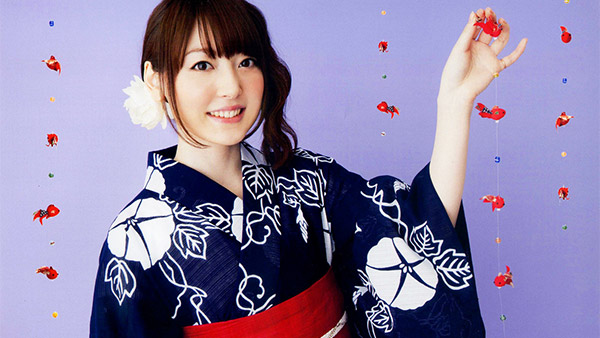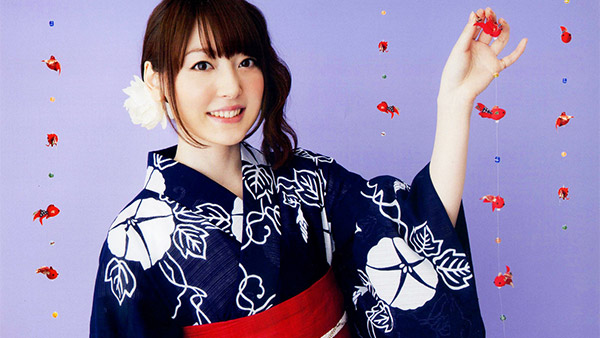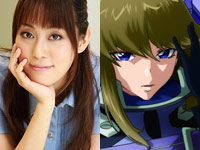
Japan’s anime industry produces more than 60% of the animated series in the world, so with all those series being produced, you’re bound to hear the same seiyu in multiple places. It could be said that a good seiyu is one you don’t notice – that is, you’re focused on the character and not the person voicing him or her. But it’s inevitable that you’ll hear someone enough that you’ll recognize them instantly upon watching a new series.
It’s really no different than live-action actors. You know who they are, but there’s a contract in place between performer and viewer that puts aside the reality for the duration of the performance. We’ve been watching anime for many years, and in that time, we’ve taken a liking to a number of seiyus’ voices, and in some cases have given series a try purely because they voice a character. For whatever reason, we’ve also always paid far more attention to the female voices than the male ones.
Hundreds of seiyus contributed to the 48 series we watched last year. The time for end-of-year lists has passed, but we thought we’d go ahead and list our 15 favorites from 2012 anyway. Note that the list only includes female seiyus who voiced at least one main/leading role in a series RABUJOI reviewed in 2012 (including dropped series). We love Chiwa Saito and Hirano Aya, for instance, but we only heard them in bit roles last year. Main characters are in bold. Our favorite characters are starred*.
Eureka Seven AO (Elena Peoples*/Miller Joe)
Last Exile: Ginyoku no Fam (Magnolia)
Moretsu Pirates (Endou Mami, Flora Chapie)
We first heard Omigawa as Maka in Soul Eater, and like that manic series, her voice is…an acquired taste. It’s a bit on the shrill side, even when she isn’t worked up, but she did a really good job toning it down with Minko in Hanasaku Iroha. She merged Maka’s energy and Minko’s angst in her turn as Elena Peoples, who can be upbeat and dorky one minute and seriously scary the next. She was a nice fit for Elena.
Girls und Panzer (Reizei Mako)
Nisemonogatari (Araragi Tsukihi*)
KoiChoco (Ougibashi Kana)
Medaka Box (Mochibaru Sasae)
Sankarea (Furuya Mero)
Sket Dance (Usami Hani)
We know Yuka well from the Index franchise, and all the roles she played in 2012 are the same kind of small, cute moe characters at which she excels. While her performances as Mako and Mero were intentionally low-energy affairs, Tsukihi was a more balanced, nuanced role, requiring her to verbally spar with the great Kamiya Hiroshi.
Sword Art Online (Kirigaya Suguha*)
Guilty Crown (Tsugumi)
Hyouka (Kimura)
Sket Dance (Obaanyan)
Prior to this year we knew Taketatsu primarily as Kirino in Oreimo, in which her role as a tsundere imouto was eventually overshadowed in our books by Kuroneko (more on her further down). With her role in SAO, we’re now comfortable labeling her the “little sister seiyu”, though that may not be entirely fair. It’s not a mark against her; her voice, capable of harsh anger, biting drama, indecision and cutesiness, is well-suited for sibling roles.
Natsuiro Kiseki (Aizawa Natsumi*)
Guilty Crown (Kusama Kanon)
Hyouka (Henmi)
Medaka Box (Nabeshima Nekomi)
Sket Dance (Akina)
Sukitte Ii na yo (Kitagawa Megumi)
Tari Tari (Mizuno Youko)
Kotobuki’s is an interesting voice capable of evoking an air of defiant earnestness and determination with underlying notes of vulnerability, which matches perfectly with Natsumi, who is strong and athletic but also emotionally uncertain. Ditto Megu-tan, who for all her glamour and popularity, is a self-loathing misanthrope nevertheless desperate to be wanted and needed.
Natsuiro Kiseki (Mizukoshi Saki*)
Tari Tari (Sakai Wakana)
Chihayafuru (Young Mashima Taichi)
Sket Dance (Nanba Kyouko)
Sword Art Online (Shinozaki Rika/Lisbeth)
It’s fitting that Saki and Natsumi are best friends who start the series with a falling-out, because Takagaki, like Kotobuki, has hints of fragile definance in her voice. We first heard Takagaki in Umi Monogatari as the very hard, cold, skeptical Kanon who eventually softened in her dealings with Marin. Saki, Wakana, and Rika are all characters that are perfectly pleasant on the surface, but whom you don’t really want to piss off.
Chuunibyou demo Koi ga Shitai! (Takanashi Rikka*)
Sankarea (Sanka Rea)
K (Hyuuga Chiho)
Kokoro Connect (Mihashi Chinatsu)
Moretsu Pirates (Yunomoto Izumi)
Uchida impressed us with both of her main roles, which both happened to be emotionally wounded individuals living outside conventional society; one by choice (Rikka), one against her will (Rea). Uchida channels the pure, innocent Rea’s deep pain from a lifetime of abuse an humiliation by her overbearing, borderline father. Rikka wasn’t the victim of abuse, but she was deceived by her parents, and she found solace in Eighth-Grade Syndrome.
Aquarion Evol (Suzushiro Mikono)
Guilty Crown (Yuzuriha Inori, Ouma Mana)
Hyouka (Ibara Mayaka)
Last Exile: Ginyoku no Fam (Millia)
Medaka Box (Kikaijima Mogana)
Rinne no Lagrange (Muginami)
Sukitte Ii na yo. (Tachibana Mei*)
Chihayafuru (Ooe Kanade)
KoiChoco (Shigemori Mao)
Moretsu Pirates (Hoshimiya Ai)
Natsuiro Kiseki (Okiyama Chiharu)
Sket Dance (Saotome Roman)
Tari Tari (Matsumoto Fumiko, Kurata Tomoka)
Kayano was the busiest of our Top 15 this year, providing talent for more than a quarter of the series we watched, plus a few we didn’t, including seven main roles. The majority of them are right in her wheelhouse: her delicate, gentle, willowy voice is ideal for characters who – at least initially – lack confidence and a sense of self worth.
You can say that about Mikono, Mayaka, Millia, Mei, Kanade, and Ai. That’s not to say she’s one note, only that she has a speciality and is good at it. Inori is a more opaque, ethereal character, while with Saotome Roman she just has fun poking at shojo tropes. But our favorite character she voiced would have to be Tachibana Mei.
Natsuiro Kiseki (Hanaki Yuka)
Sword Art Online (Yuuki Asuna*)
Tonari no Kaibutsu-kun (Mizutani Shizuku)
Accel World (Wakamiya Megumi)
Binbougami ga! (Rindou Ranmaru)
Kokoro Connect (Nishino Nana)
Moretsu Pirates (Gruier Serenity)
Sket Dance (Kanou Arisa)
With Tomatsu, versatility is the name of the game. You can’t get much different than the peppy ball of energy that is Hanaki Yuka and Mizutani “Dry Ice” Shizuku, yet she nailed both. In between those extremes was Asuna, one of the best heroines of the year despite turning into a simple damsel-in-distress in the second half of SAO. She voiced the super-girly Princess Serenity and the super-manly Rindou Ranmaru – another pair of opposites.
Amagami SS+ (Morishima Haruka)
Jormungand (Koko Hekmatyar*)
Kokoro Connect (Fujishima Maiko)
Moretsu Pirates (Misa Grandwood, Talvikki Launo)
Our first encounter with Shizuka is as Tachibana’s first conquest in the anime adaptation of the Amagami SS dating sim, in which her clear, crisp, almost aristocratic voice goes well with the character’s beauty and popularity. But there’s also a maturity to her voice, best exhibited with Misa, who is the ship’s doctor and voice of reason, and also a mentor of sorts for Marika.
She commands the respect of the crew despite her odd outfit. And then there’s Koko, the young arms dealer who seeks to force cumpulsory world peace. There’s breeding, money, and a certain arrogance in her voice, but also a keen intellect and copious confidence.
Nazo no Kanojo X (Urabe Mikoto*)
The saliva-obsessed mysterious girlfriend was 20-year-old Yoshitani’s first and to date only role, and we’re going to pilfer the sentiments from a commenter on MAL: we fell in love the second we heard her voice. It’s not your usual anime girl voice; it’s very natural, warm, sensual, and subtle. This one role was more than enough to earn her a spot on this list, and we can’t wait to hear her in something else, though it will be hard to top her performance as Urabe.
Chuunibyou demo Koi ga Shitai! (Nibutani Shinka*)
Kill Me Baby (Oribe Yasuna)
Kokoro Connect (Nakayama Mariko)
Moretsu Pirates (Harada Maki)
Tari Tari (Hirohata Nanae)
We didn’t notice Chinatsu until we watched Kill Me Baby, in which she portrays Yasuna, the comic half of the double act comprised of her and Sonya, the high school student who assassinates in her free time. As the funnier, sillier, and more unorthodox partner, Chinatsu exhibits a unique blend of manic energy, restlessness, and melodrama, when appropriate.
With Shinka she’s given a more dimensional character, one with a dorky past she’s not proud of that still leaks out. She’s a reformed weirdo, like Yuuta in a club otherwise full of raging weirdos.
Nisemonogatari (Araragi Karen*)
One Off (Maezono Rie)
Black Rock Shooter (Izuriha Kagari)
Girls und Panzer (Darjeeling, Tsuchiya)
Kyousogiga (Yase Douji)
Last Exile: Ginyoku no Fam (Tatiana Wisla)
Sket Dance (Quecchon)
It was a relatively quiet year for Kitamura, who at least in our viewing experiences specializes in portraying haughty/smug/arrogant characters like Toradora’s Kawashima Ami, though she can also do kiddie stuff like Rie. Her Tatiana in Ginyoku no Fam is a smaller, more role and is more polished, lacking the sizable chip on her shoulder in the first series.
Most of what we heard of her this year was in Nisemonogatari as the older of Koyomi’s little sisters; the one who almost lets things go a bit too far between them during a very intimate toothbrushing session.
Accel World (Kurashima Chiyuri)
Kokoro Connect (Nagase Iori*)
Last Exile: Ginyoku no Fam (Fam Fan Fan)
Medaka Box (Kurokami Medaka)
Natsuiro Kiseki (Tamaki Rinko)
Hyouka (Zenna Rie)
Like Iguchi Rika, our first exposure to Toyosaki was in Railgun, in which she portrayed the delicate but diligent, flower-crowned Uiharu. While she was pleasant enough, she was pretty much outshone by the more prominent Misaka and Shirai. In Last Exile she has top billing and a whole big steampunk world to explore as the valiant, fearless, adorable sky pirate Fam. It’s the role she was born to play, and while she gets a little preachy and idealistic towards the end, that’s the writers’ fault, not Toyosaki’s.
We were most impressed by her powerful performance as Nagase Iori, still fresh in our minds as the last four episodes were mostly about her totally losing her shit. Her descent into darkness and eventual redemption comprise some of the best character work of the year in our books, and showed that Toyosaki has the chops to do heavier stuff when called upon.
Black Rock Shooter (Takanashi Yomi/Dead Master)
Kokoro Connect (Inaba Himeko*)
Zetsuen no Tempest (Kusaribe Hakaze)
Btooom! (Kira Kousuke)
K (Awashima Seri)
Last Exile: Ginyoku no Fam (Liliana)
Natsuiro Kiseki (Aizawa Suzuka)
Nisemonogatari (Kanbaru Suruga)
Tonari no Kaibutsu-kun (Yoshida Yuuzan)
Every time we hear Sawashiro’s unmistakable voice, our ears perk up; we can’t help it. We’re not exactly sure why we like it so much; it’s a difficult thing to put into words. Is there an untranslatable Japanese term for “vulnerable strength?” Or “warm force?” Granted these aren’t traits unique to Sawashiro (many other seiyus on this list possess it), but there’s just something about her. Even if it defies easy description, Sawashiro’s golden pipes are always welcome. We could watch a Kokoro Connect spinoff focusing on Inaba Himeko all day.
Aquarion Evol (Zessica Wong)
Binbougami ga! (Sakura Ichiko)
Black Rock Shooter (Kuroi Mato)
Moretsu Pirates (Kurihara Chiaki)
From the New World (Akizuki Maria)
Zetsuan no Tempest (Fuwa Aika*)
Guilty Crown (Shinomiya Ayase)
Last Exile: Ginyoku no Fam (Alvis E. Hamilton)
Nisemonogatari (Sengoku Nadeko)
Sket Dance (Agata Saaya)
Tonari no Kaibutsu-kun (Ooshima Chizuru)
Really? We need to say why? She’s Hanazawa Kana. She’s the shit, THE END. She wields the voice of an angel sent from heaven (Ooshima, Sengoku), a demon from hell (Sakura), and everything in between: tsunderes, pirates, bitches, little sisters, shy introverts, loud exhibitionists, conflicted souls. She makes subpar characters better just by voicing them and makes good characters great.











































